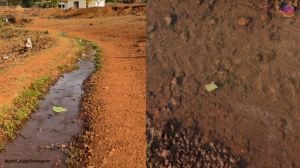- India
- International
In Odisha district, scientists team up to give farmers a new future
The farming is being supervised by top scientists from the Lucknow-based Central Institute of Medicine and Aromatic Plants (CIMAP), while the roses are being monitored by scientists from National Botanical Research Institute (NBRI).
 Krishna Nayak grows lemon grass on 2 acres. Sampad Patnaik
Krishna Nayak grows lemon grass on 2 acres. Sampad Patnaik
In one of India’s poorest districts, a team of scientists from premier central government institutes have joined hands to help farmers find new life — and hope.
“They are helping me improve farming,” says Krishna Chandra Nayak, 35, standing amidst his seven acres in Saruguda village. And his calculations on a writing pad tell a story of economic revolution through scientific inputs in agriculture.
Nayak is one of 5,000 farmers in Odisha’s Nabarangpur district, chosen and mentored under a project called ‘Farm-Based S&T Interventions for Socioeconomic Development’ being jointly implemented by 12 central R&D institutes and an 18-member district-level committee of the state government.
The project is being run under the Rashtriya Krishi Vikas Yojana (RKVY) on a budget of over Rs 6.5 crore over two years. The farmers were chosen through rigorous field visits across the district to select those who could take the risk of switching from traditional crops to high-value crops — and were willing to accept new methods.
In 2015, Nabarangpur was the focus of a year-long assigment by The Indian Express to track progress and poverty, following which the state government initiated a number of welfare and governance initiatives in the district.

With top institutes involved in the farm project since August, Nayak is growing lemon grass, turmeric, palmarosa (a grass species) and tulsi. He has started a fish pond and a rose garden, while his fields are fenced by mango, sapota and litchi trees.
“This is a dry and hilly area, where the soil does not hold moisture. It makes more sense to grow these high-value crops than paddy, which is comparatively water- and labour-intensive, and yields lower profits,” he says.
The farming is being supervised by top scientists from the Lucknow-based Central Institute of Medicine and Aromatic Plants (CIMAP), while the roses are being monitored by scientists from National Botanical Research Institute (NBRI).
Today, Nayak is confident of a profit of Rs 20,000 from just one crop of lemon grass in two acres. The turmeric will yield a profit of Rs 25,000 per acre, he hopes. The diversification of production basket, he says, over seven acres will give him upwards of Rs 3 lakh in profit.
He contrasts this with the “zero income” that much of the land used to yield because it was “unsuitable for paddy”. “Most of the land was uncultivated and a small portion was used for paddy for mostly domestic consumption,” he says.
Former Nabarangpur MP Balabhadra Majhi, who proposed the project and brought the Centre and state together to work on it, is convinced that science and technology is of more value to the district’s nearly two lakh farmers than loan waivers, money transfers, and subsidies.
“In the plateau area of Nabarangpur, people hardly eat root and green vegetables. There was no high intensity fishery, either. At 250 kg/ha, Nabarangpur’s fertiliser consumption, especially in corn cultivation, was staggering against a state average of 50kg/ha. To earn a decent income from agriculture and consume quality produce, one has to understand and apply science and technology and practice alternative farming (high-value crops over paddy),” says Majhi.
The institutes involved are mentoring a diverse group of farmers. For instance, Bhubaneswar’s Institute of Life Sciences (ILS) is training in pisciculture and poultry rearing around 173 ST, 17 SC and 28 OBC families. CIMAP will mentor 60 women Self Help Groups in making incense sticks out of tulsi leaves.
Farmers are also being helped to grow Citronella, which yields an essential oil that is used in insect and especially mosquito repellents, while palmarosa oil is an ingredient in soaps and cosmetics, says CIMAP senior scientist Prashant Rout.
“The state government will package and brand these (citronella and palmarosa) products and sell them directly to stores, as well as put up stalls in government fairs held across 30 districts of Odisha,” says Uma Maheshwar, who heads the Nabarangpur district wing of Odisha Rural Marketing Society.
Irfan Khan owns over seven hectares of water stretch (ponds) in which he is practising pisciculture under guidance of Central Institute of Freshwater Aquaculture (CIFA). “To get Rs 12,000 worth brood stock of fish I used to travel up to Sambalpur and spend another Rs 10,000 on fuel, food and lodgings. Even then, the quality (of fingerlings) was not great,” says Irfan. “Now CIFA has stocked my ponds with top notch breeds like Jayanti Rohi, improved catla.”
CIFA’s Principal Scientist S S Mishra lands at Irfan’s property to inspect and advise. “Nabarangpur is a low alkaline area so we must add limestone powder and maintain pH. The fish feed must be given correctly. The fish have to be protected against fish lice, skin fluke,” says Mishra.
In Papadahandi block, Dhansingh Batra, who owns only two acres, is elated to be advised by Dr K Lakshminarayana of Central Tuber Crops Research Institute (CTCRI) on how to plant his sweet potato crop so that the vines don’t retain moisture and rot.
“Earlier this year, I made a profit of Rs 15,000 on five quintals of sweet potato grown on only 0.2 acres of land,” says Batra. “I have kept another quintal for consumption by family and friends. I used to grow corn that gave me a profit of only Rs 20,000 from one acre.”
Apr 26: Latest News
- 01
- 02
- 03
- 04
- 05








































